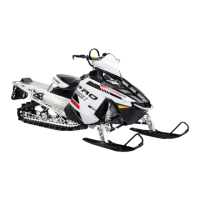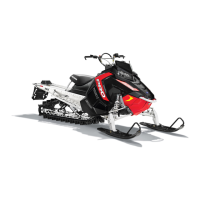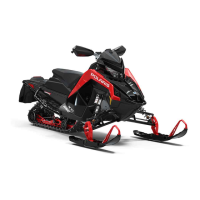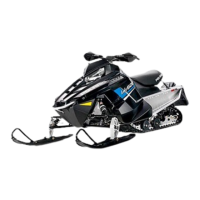4.4
Cleanfire Fuel Injection
ENGINE PROTECTION FEATURES
Engine Temperature RPM Limit
The ECU will illuminate the instrument cluster engine hot
LED when it determines the engine is overheating. The
ECU will flash the hot LED and enable a RPM misfire if it
determines continued engine operation will cause serious
engine damage. The ECU makes this determination
based on current engine coolant temp, engine RPM, and
throttle position.
NOTE: * = Only minimum (idle
) and maximum (WOT)
parameters listed.
The driver must take immediate action to cool the engine
once the
hot LED is illuminated. Drive the snowmobile in
loose, un-packed snow to cool the engine. If trail
conditions are poor, turn the engine off and allow it to cool.
When the engine is cool, check the coolant level in the
sur
ge bottle (reservoir). Only add coolant when the engine
is sufficiently cooled. Never add coolant when engine is
hot.
If the snowmobile must be operated while the indicator
LE
D is illuminated, drive slowly and stop the engine
frequently to allow it to cool down.
Continued engine operation with the engine hot LED
illuminated may caus
e serious engine damage. If the ECU
determines serious engine damage may occur, the hot
lamp will flash and an engine RPM misfire will be enabled.
The ECU will also register and accumulate (c
ount the
number of occurrences) DTCs (110/0 or 110/16) if the
engine overheats or goes into the overheat misfire mode.
Engine Overheating Troubleshooting
If the hot lamp is illuminated or flashing with the engine
overheat RPM misfire enabled, reference the table below.
Engine Temperature Limit Modes
MODEL
HOT
LAMP
MODE
THRESHOLD
*
600/800
DC-CFI 2/4
Hot Lamp ON
Hot Lamp Illuminates:
Idle = 230° F/110° C
WOT = 185° F/85° C
Hot Lamp
FLASH
Hot Lamp Flashes
RPM Misfire at:
Idle = 239° F/115° C
WOT = 208° F/98° C
CAUSE OF OVERHEAT SOLUTION
Riding in poor conditions
Ride snowmobile on good
snow (loose, fresh, un-packed
snow)
Low coolant level
Allow engine to cool. Refill
cool
ant surge bottle to COLD
line
Incorrect coolant/mix ratio
Use 60/40 (ethylene glycol/
di
stilled water mixture
Air in cooling system Bleed cooling system
Heat exchangers/hoses
damaged or plugged
Inspect components for
damage, hose kinks, etc.
Thermostat malfunctioning
Inspect thermostat for proper
op
eration
Water pump malfunctioning Inspect coolant flow
Cylinder base gaskets/o-rings
damaged.
Pressure test cooling system.
Verify system holds pressure/
pressure does not leak into
cylinders
Snow flap damaged or
removed
Inspect rear snow flap
assembly
. Verify flap(s) are not
damaged or missing
Vehicle use
Verify vehicle is not overloaded
du
ring operation (high load/
high engine RPM and low
ground speed)
Track condition/tension
Verify track is not missing lugs.
Set c
orrect track tension

